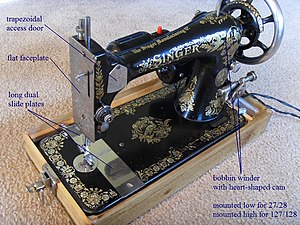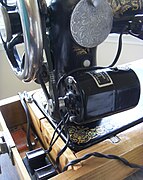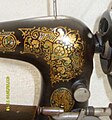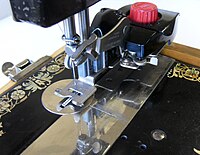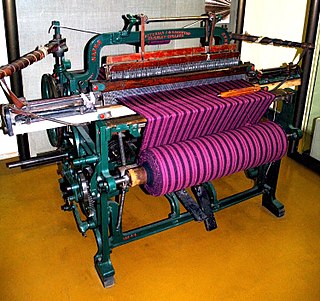
A loom is a device used to weave cloth and tapestry. The basic purpose of any loom is to hold the warp threads under tension to facilitate the interweaving of the weft threads. The precise shape of the loom and its mechanics may vary, but the basic function is the same.

A sewing machine is a machine used to sew fabric and materials together with thread. Sewing machines were invented during the first Industrial Revolution to decrease the amount of manual sewing work performed in clothing companies. Since the invention of the first sewing machine, generally considered to have been the work of Englishman Thomas Saint in 1790, the sewing machine has greatly improved the efficiency and productivity of the clothing industry.

A bobbin or spool is a spindle or cylinder, with or without flanges, on which yarn, thread, wire, tape or film is wound. Bobbins are typically found in industrial textile machinery, as well as in sewing machines, fishing reels, tape measures, film rolls, cassette tapes, within electronic and electrical equipment, and for various other applications.

A lockstitch is the most common mechanical stitch made by a sewing machine. The term "single needle stitching", often found on dress shirt labels, refers to lockstitch.

Machine embroidery is an embroidery process whereby a sewing machine or embroidery machine is used to create patterns on textiles. It is used commercially in product branding, corporate advertising, and uniform adornment. It is also used in the fashion industry to decorate garments and apparel. Machine embroidery is used by hobbyists and crafters to decorate gifts, clothing, and home decor. Examples include designs on quilts, pillows, and wall hangings.

The White Sewing Machine Company was a sewing machine company founded in 1858 in Templeton, Massachusetts, by Thomas H. White and based in Cleveland, Ohio, since 1866.

Philip H. Diehl was a German-American mechanical engineer and inventor who held several U.S. patents, including electric incandescent lamps, electric motors for sewing machines and other uses, and ceiling fans. Diehl was a contemporary of Thomas Edison and his inventions caused Edison to reduce the price of his incandescent bulb.

Allen Benjamin Wilson (1823–1888) was an American inventor famous for designing, building and patenting some of the first successful sewing machines. He invented both the vibrating and the rotating shuttle designs which, in turns, dominated all home lockstitch sewing machines. With various partners in the 19th century he manufactured reliable sewing machines using the latter shuttle type.
Wheeler & Wilson was an American company which produced sewing machines. The company was started as a partnership between Allen B. Wilson and Nathaniel Wheeler after Wheeler agreed to help Wilson mass-produce a sewing machine he designed. The two launched their enterprise in the early 1850s, and quickly gained widespread acclamation for their machines' designs. Both Wheeler and Wilson died in the late 19th century, resulting in the company's sale to the Singer Corporation. Shortly after, the Singer Corporation phased out Wheeler & Wilson's designs. The company sold a total of nearly 2,000,000 sewing machines during its existence.
A vibrating shuttle is a bobbin driver design used in home lockstitch sewing machines during the second half of the 19th century and the first half of the 20th century. It supplanted earlier transverse shuttle designs, but was itself supplanted by rotating shuttle designs.
A zigzag stitch is variant geometry of the lockstitch. It is a back-and-forth stitch used where a straight stitch will not suffice, such as in reinforcing buttonholes, in stitching stretchable fabrics, and in temporarily joining two work pieces edge-to-edge.

The rotary hook or rotating hook is a bobbin driver design used in lockstitch sewing machines since the 19th century. It triumphed over competing designs because it can run at higher speeds with less vibration. Rotary hooks and oscillating shuttles are the two most common bobbin drivers in use today.

Throughout history, lockstitch sewing machines have used a variety of methods to drive their bobbins so as to create the lockstitch.

The White Family Rotary or White FR, later White Rotary or White Rotary Electric, was the first rotary hook sewing machine produced by the White Sewing Machine Company, introduced circa 1900. It joined the successful White Vibrating Shuttle on White's expanding product line and eventually eclipsed it. It was originally sold as a treadle with cabinet or as a hand-crank with carrying case. Later, add-on electric motors with foot or knee control were available pre-installed or as a field upgrade. Typical cost for this machine as a treadle with a cabinet was US$65 in 1909, which is about US$1532 adjusted.

The White Sewing Machine was the first sewing machine from the White Sewing Machine Company. It used a vibrating shuttle bobbin driver design. For that reason, and to differentiate it from the later White Family Rotary that used a rotary hook design instead, it came to be known as the "White Vibrating Shuttle" or "White VS". In 1879 it cost USD50 to US$125 depending on which table or cabinet it was to be mounted in. The White VS continued in production, with improvements, until the early 1900s.
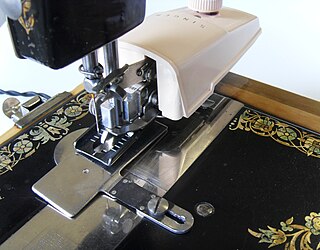
A buttonholer is an attachment for a sewing machine which automates the side-to-side and forwards-and-backwards motions involved in sewing a buttonhole.
The Jones Sewing Machine Company was a British manufacturer of sewing machines founded in 1860 by William Jones and Thomas Chadwick under the name Chadwick and Jones, which later became known as the Jones Sewing Machine Company. The company produced sewing machines for almost 100 years, before being acquired by Brother Industries in 1968.

The Singer Featherweight is a model series of lockstitch domestic sewing machines produced by the Singer Manufacturing Company from 1933 to 1968, significant among sewing machines for their continuing popularity, active use by quilters and high collector's value.
Kimball & Morton were a Glasgow-based manufacturer of domestic and industrial sewing machines active between 1867 and 1955.
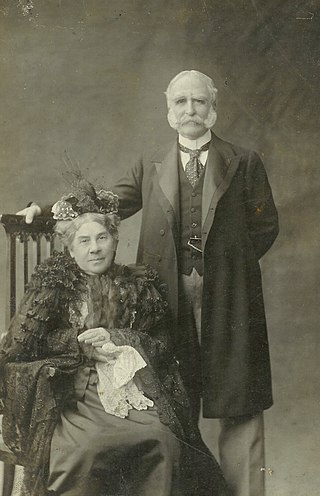
Harriet Ruth Brisbane Tracy (1834-1918) was born on December 6, 1834, in Charleston, South Carolina. She was a prolific and successful inventor who is credited to have received 27 patents from 1868 to 1915. These patents were in a multitude of fields such as elevators, sewing machines, and crib attachments. Of the 27 patents, six were for elevators and seventeen were for sewing machines. Ten of these patents came during a very productive period from 1890 to 1893. Of her inventions, the most renowned was her Tracy Gravity Safety Elevator. Tracy’s other notable innovations were her sewing machines and crib attachments. She died on May 30, 1918, at the age of 83; according to her obituary she was also "gifted as a writer of verse and prose", contributing frequently to "magazines and periodicals."
